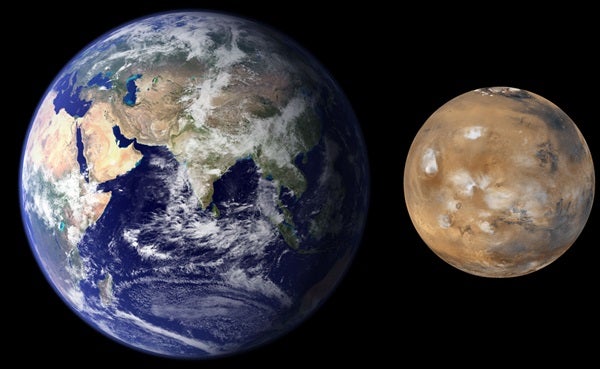“This numerical simulation actually reproduces the structure of the inner solar system, with Earth, Venus, and a smaller Mars,” said Hal Levison from SwRI.
The fact that Mars has only 10 percent of the mass of Earth has been a long-standing puzzle for solar system theorists. In the standard model of planet formation, similarly sized objects accumulate and assimilate through a process called accretion — rocks incorporated other rocks, creating mountains, then mountains merged to form city-sized objects, and so on. While typical accretion models generate good analogs to Earth and Venus, they predict that Mars should be of similar size or even larger than Earth. Additionally, these models also overestimate the overall mass of the asteroid belt.
“Understanding why Mars is smaller than expected has been a major problem that has frustrated our modeling efforts for several decades,” said Levison. “Here, we have a solution that arises directly from the planet formation process itself.”
New calculations by Levison and co-authors Katherine Kretke, Kevin Walsh, and Bill Bottke, all of SwRI, follow the growth and evolution of a system of planets. They demonstrate that the structure of the inner solar system is actually the natural outcome of a new mode of planetary growth known as Viscously Stirred Pebble Accretion (VSPA). With VSPA, dust readily grows to “pebbles” — objects a few inches in diameter — some of which gravitationally collapse to form asteroid-sized objects. Under the right conditions, these primordial asteroids can efficiently feed on the remaining pebbles as aerodynamic drag pulls pebbles into orbit, where they spiral down and fuse with the growing planetary body. This allows certain asteroids to become planet-sized over relatively short time scales.
However, these new models find that not all of the primordial asteroids are equally well-positioned to accrete pebbles and grow. For example, an object the size of Ceres — about 600 miles (1,000 kilometers) across — which is the largest asteroid in the asteroid belt, would have grown quickly near the current location of Earth. But it would not have been able to grow effectively near the current location of Mars, or beyond, because aerodynamic drag is too weak for pebble capture to occur.
“This means that very few pebbles collide with objects near the current location of Mars. That provides a natural explanation for why it is so small,” said Kretke. “Similarly, even fewer hit objects in the asteroid belt, keeping its net mass small as well. The only place that growth was efficient was near the current location of Earth and Venus.”
“This model has huge implications for the history of the asteroid belt,” said Bottke. Previous models have predicted that the belt originally contained a couple of Earth-masses’ worth of material, meaning that planets began to grow there. The new model predicts that the asteroid belt never contained much mass in bodies like the currently observed asteroids.
“This presents the planetary science community with a testable prediction between this model and previous models that can be explored using data from meteorites, remote sensing, and spacecraft missions,” said Bottke.
This work complements the recent study by Levison, Kretke, and Martin Duncan, from Queen’s University, which demonstrated that pebbles can form the cores of the giant planets and explain the structure of the outer solar system. Combined, the two works present the means to produce the entire solar system from a single, unifying process.
“As far as I know, this is the first model to reproduce the structure of the solar system — Earth and Venus; a small Mars; a low-mass asteroid belt; two gas giants; two ice giants, Uranus and Neptune; and a pristine Kuiper Belt,” said Levison.










